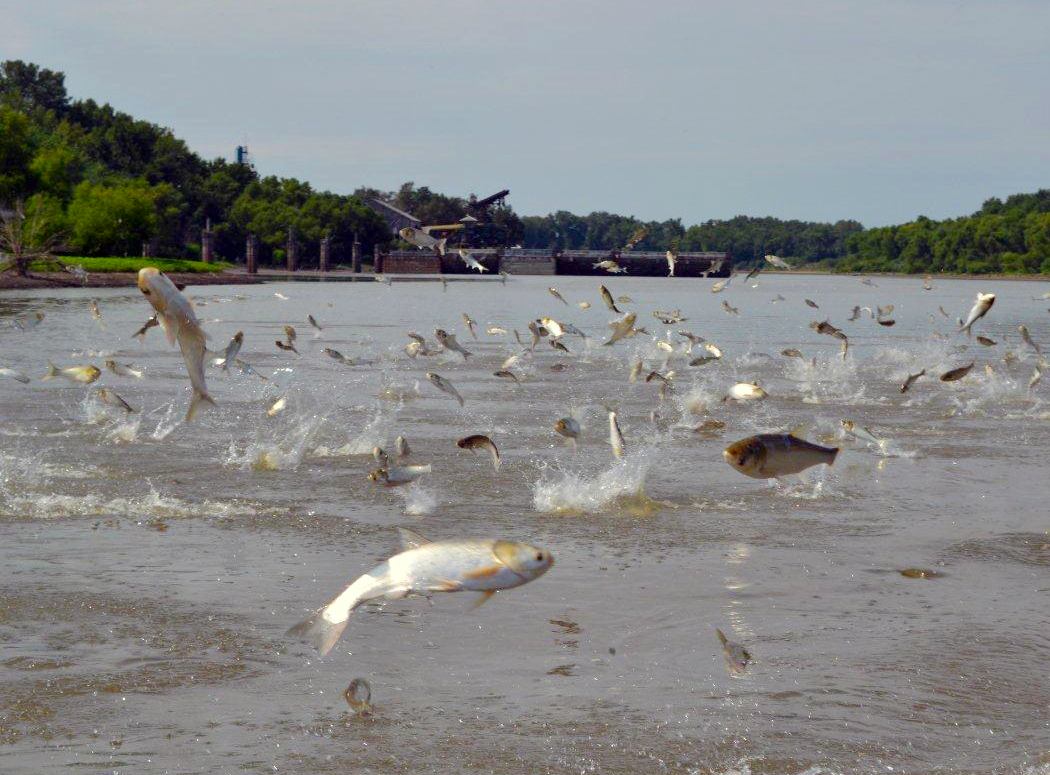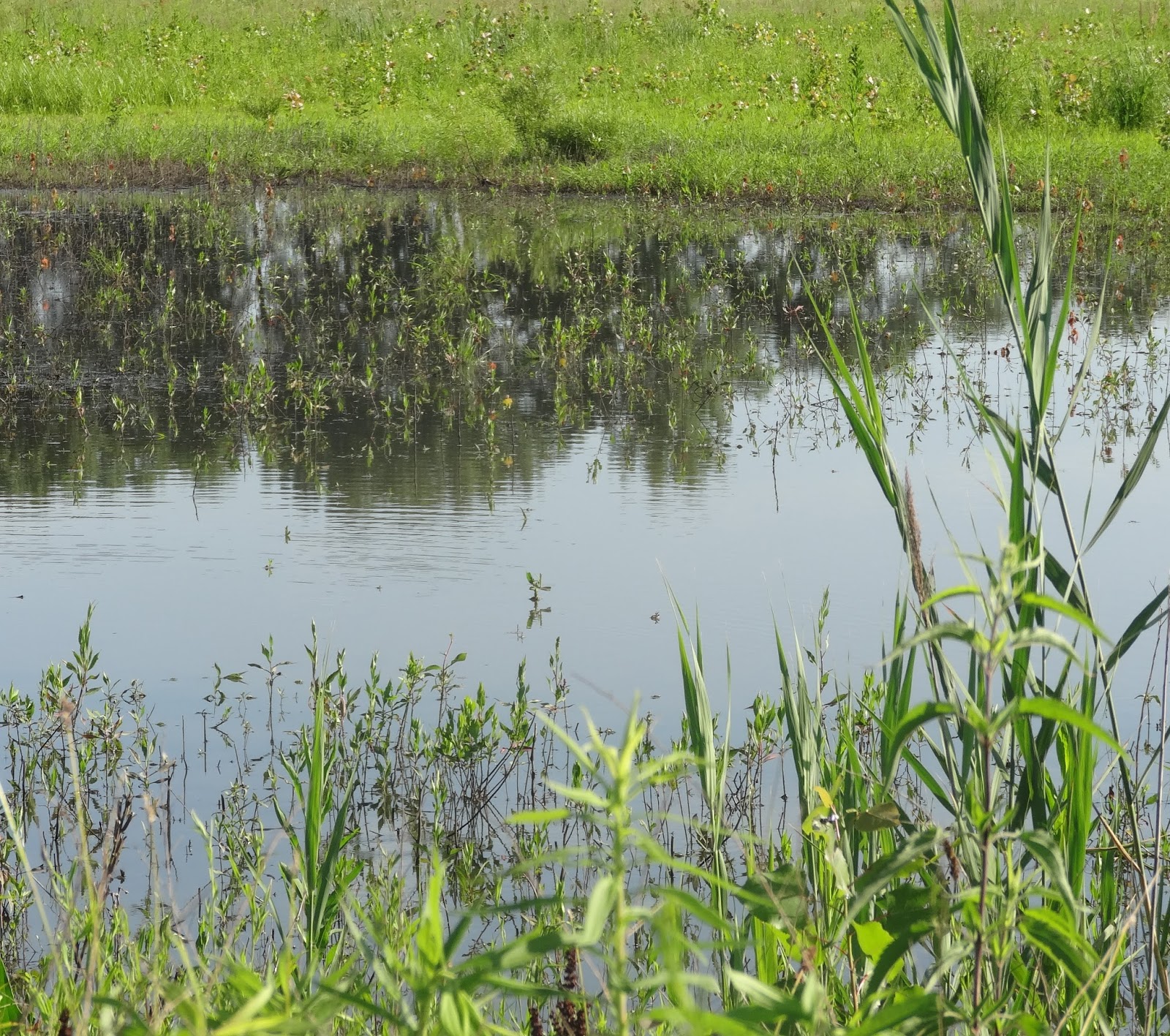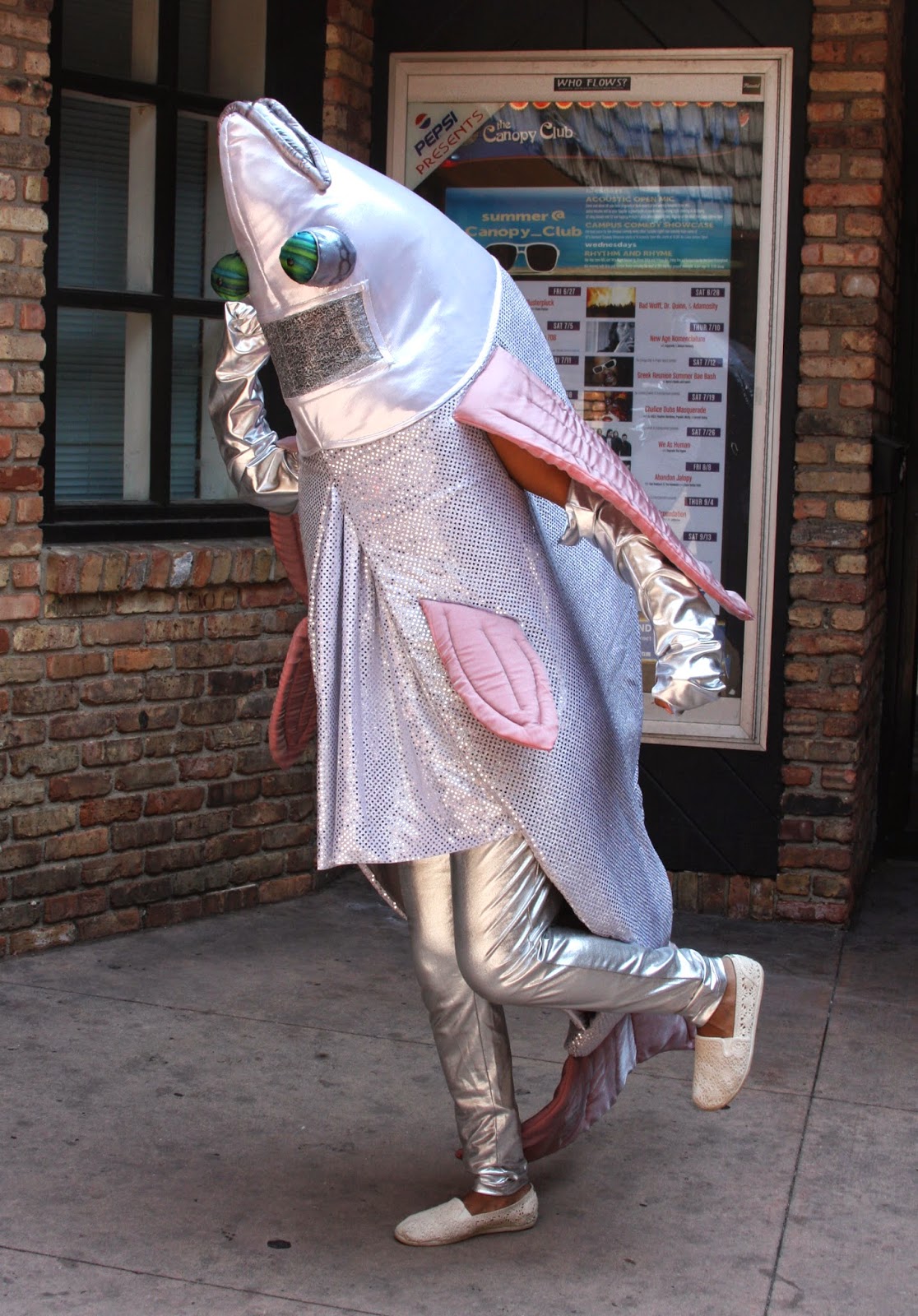October 28th, 2014 by iisg_superadmin
Earlier this month, officials in Michigan announced that genetic material from silver carp, a species of Asian carp, had been discovered in the Kalamazoo River around 20 miles upstream from where the river flows into Lake Michigan. It was the first time a positive sample of eDNA had been found that close to the lake.
 The results drew national attention and had many concerned that it wouldn’t be long until the infamous invader entered the Great Lakes. Further testing, though, reveals that there is no evidence of Asian carp in the river, Lake Michigan, or any of the other Great Lakes.
The results drew national attention and had many concerned that it wouldn’t be long until the infamous invader entered the Great Lakes. Further testing, though, reveals that there is no evidence of Asian carp in the river, Lake Michigan, or any of the other Great Lakes.
“We are pleased these samples were negative, but that doesn’t mean our efforts to keep Michigan’s waters are over,” DNR Fisheries Division Chief Jim Dexter said in a statement.
Asian carp were imported in the South several decades ago, where they served a utilitarian role on fish farms. But with no natural predator, the prodigious eaters and reproducers quickly escaped and began steadily invading the Mississippi River system.
Having arrived on the doorsteps of the Great Lakes, officials in Michigan, Ohio, Wisconsin, Pennsylvania, New York and others are working diligently to organize a strategy for keeping the invasive swimmers out.
Environmentalists, ecologists and others say the carp could decimate food chains and habitats in the Great Lakes, diminishing biodiversity there and threatening a multibillion-dollar fishing industry.
The threat comes from the invaders ravenous diet and ability to out-compete native fish for food. In the Illinois River, they have already fundamentally changed the food web.
From the Spring 2013 Helm:
Asian carp do more than compete for food. They actually force native fish to change their diets, feeding on species lower on the food chain than they natural would. In a healthy food web, filter-feeders, like gizzard shad and paddlefish, eat a variety of plankton species, ensuring that there is enough food to go around. But Asian car have all but wiped out the larger zooplankton in the Illinois River, pushing fish that have historically relied on that food source to turn to smaller zooplankton and phytoplankton for a meal. As the number of Asian carp in an area grows, more and more native fish are left competing for a smaller supply of plankton.
To learn more about Asian carp and efforts to prevent their spread, visit our Aquatic Invasive Species page.
***Photo courtesy of the Asian Carp Regional Coordinating Committee
October 28th, 2014 by iisg_superadmin
With the end of Chicago’s boating season right around the corner, we thought this would be a good time look back at this year’s progress making boating and harbor activities more environmentally friendly.
The Illinois Clean Marina Program launched last year with one certified marina, 31st Street Harbor. This year, five new harbors joined the ranks by implementing a series of best management practices, bringing the state total to six in just its first year. Two more, North Point Marina and Diversey Harbor have also pledged to implement these same practices.
 Clean boating includes preventing the spread of aquatic invasive species (AIS). It was a banner year for Clean Boats Crew, an outreach effort that gives boaters, anglers, and others the information they need to stop the spread of AIS. During its four-year tenure, the volunteer program has spread the word about AIS prevention to more than 8,000 recreational water users in Illinois and Indiana, with more than 3,500 people reached this year alone.
Clean boating includes preventing the spread of aquatic invasive species (AIS). It was a banner year for Clean Boats Crew, an outreach effort that gives boaters, anglers, and others the information they need to stop the spread of AIS. During its four-year tenure, the volunteer program has spread the word about AIS prevention to more than 8,000 recreational water users in Illinois and Indiana, with more than 3,500 people reached this year alone.
The idea behind Clean Boats Crew is simple. Volunteers visit boat ramps and docks during the height of the boating season to talk with boaters, anglers, and other recreational water users about AIS and to demonstrate cleaning techniques that can help stop their spread. This year, site leaders and volunteers were onsite at Chicago’s Burnham and Diversey harbors, as well as Illinois’s Chain O’ Lakes and North Point Marina and Indiana’s East Chicago and Portage marinas.
 In Illinois, site leaders and volunteers introduced water users to three simple steps at the heart of the prevention campaign Be a Hero – Transport Zero™:
In Illinois, site leaders and volunteers introduced water users to three simple steps at the heart of the prevention campaign Be a Hero – Transport Zero™:
–Remove plants, animals, and mud from all equipment
–Drain all water from your boat and gear
–Dry everything thoroughly with a towel
With the season over, IISG and the Northeast Illinois Invasive Plant Partnership, co-organizers of the Clean Boats Crew program, have turned their sights to next year and are looking for others to join the effort.
October 16th, 2014 by iisg_superadmin
 Even before zebra and quagga mussels arrived in the Great Lakes in the 1980s, the future looked a little bleak for native mussels. The invaders came close to wiping them out entirely. But small populations in Lake Erie appear to not only be surviving the invasion, but thriving.
Even before zebra and quagga mussels arrived in the Great Lakes in the 1980s, the future looked a little bleak for native mussels. The invaders came close to wiping them out entirely. But small populations in Lake Erie appear to not only be surviving the invasion, but thriving.
Average density of native mussels before the arrival of zebra mussels was two per square meter in Lake St. Clair. By 1990, zebra mussel density was at 1,600 per square meter.
“By 1992, native mussel populations are almost gone from the southeastern portion of the lake and declining rapidly in the northwestern portion of the lake,” said [Dave] Zanatta, [a biologist at Central Michigan University].
By 1994, there were almost no native mussels left in the lake, with zebra now at 3,000+ per square meter.
“But there was reason for hope,” said Zanatta. “Remnant populations of native mussels were beginning to be found in coastal wetlands in western Lake Erie in the late 1990s.”
More recent research funded through the Great Lakes Restoration Initiative also reveals that native mussels have maintained genetic diversity, a key to any species’ long-term survival.
Again from The Voice:
Zanatta’s research adds further evidence that progress continues to be made on one of the impairments of the St. Clair River – the degradation of fish and wildlife habitat – that led to its classification as an environmental Area of Concern in 1985.
His work also sheds light on the complex ecological impacts of invasive species generally.
With some environmental observers predicting a doomsday scenario for native game fish if Asian carp are able to establish themselves in the Great Lakes, for example, Zanatta’s mussel research suggests that the outlook for native fish might be significantly more positive than forecasts suggest.
To read the full article, click on the link above.
**Photo of zebra mussels courtesy of Michigan Sea Grant.
September 26th, 2014 by iisg_superadmin
 The U.S. EPA announced a new plan to improve water quality and restore habitats in the Great Lakes earlier this week during a meeting of region’s mayors in Chicago. The five-year plan, known as the Great Lakes Restoration Initiative Action Plan II, calls for a dramatic expansion of urban stormwater management projects and a more than 1,400 ton reduction in phosphorus fertilizer runoff. It also roughly doubles the number of acres covered by efforts to control invasive species and requires that new wetlands include plants that can thrive as climate change brings warmer temperatures.
The U.S. EPA announced a new plan to improve water quality and restore habitats in the Great Lakes earlier this week during a meeting of region’s mayors in Chicago. The five-year plan, known as the Great Lakes Restoration Initiative Action Plan II, calls for a dramatic expansion of urban stormwater management projects and a more than 1,400 ton reduction in phosphorus fertilizer runoff. It also roughly doubles the number of acres covered by efforts to control invasive species and requires that new wetlands include plants that can thrive as climate change brings warmer temperatures.
From The New York Times
It builds on a four-year initiative, begun in President Obama’s first term, that has already spent $1.6 billion on more than 2,100 restoration projects on the lakes’ American side. The added initiative, which extends through 2019, is expected to cost roughly the same.
The government says the project is the largest conservation program in the nation’s history, involving 15 federal agencies and the eight Great Lakes states. Read more
 In addition to laying out new strategies, the latest phase of the Great Lakes Restoration Initiative continues efforts to clean up Areas of Concern across the region, where polluted water and contaminated sediment pose a risk to wildlife and public health. Five of these largely industrial rivers and harbors have been restored in the last four years, and 10 more are slated for cleanup by 2019.
In addition to laying out new strategies, the latest phase of the Great Lakes Restoration Initiative continues efforts to clean up Areas of Concern across the region, where polluted water and contaminated sediment pose a risk to wildlife and public health. Five of these largely industrial rivers and harbors have been restored in the last four years, and 10 more are slated for cleanup by 2019.
September 16th, 2014 by iisg_superadmin
Our education team is at it again! Allison Neubauer wrote in with this exciting announcement:
 Teachers across the Great Lakes region—have we got a treat for you! You can now explore creative projects from all-star educators to spark new ideas and read important tips for getting your students involved in the effort to “nab” local aquatic invaders.
Teachers across the Great Lakes region—have we got a treat for you! You can now explore creative projects from all-star educators to spark new ideas and read important tips for getting your students involved in the effort to “nab” local aquatic invaders.
The IISG education team has been working hard to compile model projects that successfully tie together AIS education and community stewardship. Our revamped Nab the Aquatic Invader! website will help you up your game—and the new-and-improved Top Desk Administrator is your one-stop-shop for project ideas.
Community stewardship projects like the ones highlighted here are an exceptional tool for pushing students beyond rote memorization and providing them with an opportunity to apply their knowledge in ways that have positive impacts on their communities.
Preview outstanding examples of student work, ranging from fun informational activity books to catchy musical compilations. When you’re done perusing, read the summary reports written by the teachers responsible for these successful activities for information on how to plan and implement similar projects in your own classroom.
The Nab the Aquatic Invader! website is the place for the latest and greatest invasive species project models, information, and activities.
September 15th, 2014 by iisg_superadmin
When researchers and the media talk about Asian carp reaching the Great Lakes, they are typically referring to bighead and silver carp, the two voracious phytoplankton eaters that are wreaking havoc in places like the Mississippi and Illinois rivers. But the species most likely to establish in Lake Erie may actually be a third member of the Asian carp family: grass carp.
From The Voice:

“Grass carp are a different kind of fish and pose different kinds of risk than bighead and silver carp,” said Jeff Tyson, administrator of the Lake Erie Fisheries Program Administrator for the Ohio Department of Natural Resources. Tyson addressed a meeting of environmental writers at Ohio State University’s Stone Lab in Lake Erie on Aug. 18. “We know we have some grass carp in the system. Grass carp impact the system through their impacts on structure and vegetation. They consume huge amounts of vegetation.”
Grass carp could put Lake Erie at risk “by damaging habitats and damaging fish in communities given the documented reproduction of grass carp in large rivers,” according to the Ohio Asian Carp Tactical Plan, 2014-2020. “Grass carp can also decimate submersed aquatic vegetation that is critical to migrating waterfowl and other water birds.” Read more.
**Photo courtesy of Eric Engbretson, US Fish and Wildlife Service, Bugwood.org.
August 27th, 2014 by iisg_superadmin
Summer is coming to an end, but there is still plenty of fun to be had this weekend. If you’re like us, you’re anxious to hit the road to your favorite beach, boat launch, or fishing spot. But before you do, we have a message that will help keep these places healthy for many Labor Days to come. And you may just see it on the car in front of you.
The Illinois Department of Natural Resources has emblazoned nine vehicles with a reminder to Be a Hero—Transport Zero. It’s all part of a statewide program that is raising awareness about how the public can help prevent the spread of invasive species on land and in waterways. These plants and animals can wreak havoc on food webs, water quality, and recreation. The three featured in IDNR’s tailgate designs—Asian carp, zebra mussel, and hydrilla—are some of the worst offenders, but there are many more, and they aren’t always easy to recognize.
So what can you do? Just follow three easy steps before you leave the water this weekend:
– Remove any plants, animals, and mud from boats, trailers, and equipment
– Drain everything—bait buckets, live wells, etc.
– Dry everything with a towel
From boaters and kayakers to waterfowl hunters, scuba divers, swimmers, and more, we can all help prevent invasive species from taking over our favorite waterways.
See you on the water!
August 12th, 2014 by iisg_superadmin
Illinois teacher Carol Schnaiter has big plans for her classes at Amboy Central School. Carol was one of 14 teachers to participate in IISG’s B-WET workshop last year. And this summer, she spent two weeks in the Gulf of Mexico aboard the NOAA research vessel Oregon II. Carol wrote in to tell us about her experiences at both, how they have already shaped her curriculum, and what she has planned for her students this year.
“I am constantly looking for workshops, classes, and events that I can attend and bring what I learned back to my class. Each adventure adds to our classroom and allows the students to learn something new.
 I was very excited when I was selected for the B-WET workshop in June of 2013. After the workshop, I added an entire unit on invasive species in the Great Lakes area for the 4th graders and another unit on restoration for the 3rd graders, plus I expanded the watershed unit I was teaching to the third graders. At the end of the units, I invited a guest speaker from the Amboy Marsh, Greg Hunter, to speak to all my classes about the Amboy Marsh and invasive species in our area. We then went to the Amboy Marsh, where the students pulled the invasive Garlic Mustard plant and cleaned away brush. The staff also arranged for guest speakers to talk about turtles, birds, and plants and gave a walking tour of the marsh. My colleagues and I are hoping to continue working with Amboy Marsh when we do our invasive species unit and our restoration unit each year.
I was very excited when I was selected for the B-WET workshop in June of 2013. After the workshop, I added an entire unit on invasive species in the Great Lakes area for the 4th graders and another unit on restoration for the 3rd graders, plus I expanded the watershed unit I was teaching to the third graders. At the end of the units, I invited a guest speaker from the Amboy Marsh, Greg Hunter, to speak to all my classes about the Amboy Marsh and invasive species in our area. We then went to the Amboy Marsh, where the students pulled the invasive Garlic Mustard plant and cleaned away brush. The staff also arranged for guest speakers to talk about turtles, birds, and plants and gave a walking tour of the marsh. My colleagues and I are hoping to continue working with Amboy Marsh when we do our invasive species unit and our restoration unit each year.
 The students loved learning about the invasive species! We used the cards from the Sea Grant curricula and played games, such as Beat the Barriers. The students also did research on the various species and used the watch cards. When Mr. Hunter came in to speak, the students had background information on invasive species and were able to connect with what he was discussing.
The students loved learning about the invasive species! We used the cards from the Sea Grant curricula and played games, such as Beat the Barriers. The students also did research on the various species and used the watch cards. When Mr. Hunter came in to speak, the students had background information on invasive species and were able to connect with what he was discussing.
This summer, I took part in the NOAA Teacher at Sea Program in the Gulf of Mexico. While on the ship, I worked with NOAA scientists and the crew to learn about the Gulf ecosystems first-hand and watch real science in action. I was on the midnight-to-noon shift for 16 days. We traveled to “stations” across the Gulf where we dropped the trawling net, the bongo nets, and the CTD (conductivity, temperature, and depth) sensors as part of the Groundfish Survey. Once the nets were brought up, we would count, measure, weigh, and record the sex of all the species. Our main objective was to collect information and send it to federal agencies that used it to set the shrimp season and catch limits.
 As a result of this experience, I am working on adding more information to our invasive species unit and creating another unit that will have the students trace the water from the Great Lakes watershed to the Gulf of Mexico. We will be following the NOAA Ship Oregon II as they go out for the fall Groundfish Survey and adding that information to the data collected while I was aboard this summer. We will be watching the water’s oxygen levels as the ship travels across the Gulf and will try to figure out what might be the cause of any changes.
As a result of this experience, I am working on adding more information to our invasive species unit and creating another unit that will have the students trace the water from the Great Lakes watershed to the Gulf of Mexico. We will be following the NOAA Ship Oregon II as they go out for the fall Groundfish Survey and adding that information to the data collected while I was aboard this summer. We will be watching the water’s oxygen levels as the ship travels across the Gulf and will try to figure out what might be the cause of any changes.
Tying both the B-WET workshop and my experience on a working research ship together will allow the students to see how everyday science is touching our lives.”
July 30th, 2014 by iisg_superadmin

Jumpin’ Jack, the silver carp sensation known for his glam look and high-flying stage tricks, will join Lady Quagga on tour of schools and public events starting this month.
Despite differences in their history and style, the two have been dubbed a ‘captivating duo’ by many critics. Several experts have also commended the “spokes-mussel” and “flying fish” for dedicating their tour to spreading the word about the risks of
aquatic invasive species and how people can help prevent their spread.
Jumpin’ Jack, along with his cousin bighead carp, initially came to the U.S. in the 1970s to help control algae growth in aquaculture and municipal wastewater treatment plants. They soon moved to nearby lakes and rivers and are now a common sight on major rivers like the Illinois and Mississippi. Together, these Asian carp have knocked back plankton populations, crowded out native species, and seriously injured boaters.
In addition to traveling with Lady Quagga, Jumpin’ Jack is also booking independent appearances. Contact his manager,
Terri Hallesy, for more information.
 The results drew national attention and had many concerned that it wouldn’t be long until the infamous invader entered the Great Lakes. Further testing, though, reveals that there is no evidence of Asian carp in the river, Lake Michigan, or any of the other Great Lakes.
The results drew national attention and had many concerned that it wouldn’t be long until the infamous invader entered the Great Lakes. Further testing, though, reveals that there is no evidence of Asian carp in the river, Lake Michigan, or any of the other Great Lakes. 















